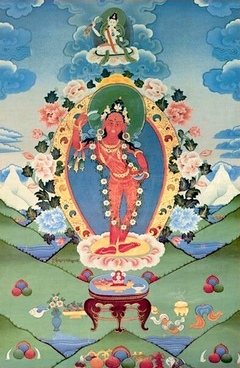Yeshe Tsogyal Sādhana
༄༅། །ཆོས་ཉིད་མཁའ་འགྲོའི་གསང་མཛོད་ལས༔ ཡེ་ཤེས་མཁའ་འགྲོའི་སྒྲུབ་ཐབས་དངོས་གྲུབ་དཔལ་སྟེར་བཞུགས༔
The Wisdom Ḍākinī’s Sādhana Glorious Bestower of Attainments
from The Secret Treasury of Ultimate Reality Ḍākinīs
revealed by Sera Khandro
ན་མོ་པདྨ་ཀཱ་ར་ཡེ༔
Namo Padmākarāye༔
སྐྱེ་མེད་སྤྲོས་བྲལ་ཆོས་སྐུ་ཀུན་བཟང་མོ༔
མ་འགགས་རང་གསལ་ལོངས་སྐུ་ཝཱ་ར་ཧི༔
ཐུགས་རྗེ་མཛད་པ་བསམ་འདས་མཚོ་རྒྱལ་མ༔
སྐུ་གསུམ་མཁའ་འགྲོའི་ཚོགས་ལ་གུས་པས་འདུད༔
རྣལ་འབྱོར་དམ་ཚིག་ལྡན་པའི་སྐྱེས་བུ་ཡིས༔
ཡེ་ཤེས་ཌཱ་ཀིའི་གསང་བའི་སྒྲུབ་ཐབས་ནི༔
སྤྲོས་མེད་རྒྱུན་ཁྱེར་ཟག་མོའི་གདམས་པ་བསྟན༔
ས་མ་ཡ༔
To the unborn, unfabricated dharmakāya Samantabhadrī,
The unceasing, naturally lucid saṃbhogakāya Vārāhī,
performer of inconceivably compassionate acts, Tsogyalma,
and the assembly of trikāya ḍākinīs, I offer homage.
For yogis endowed with samaya,
I will teach this secret sādhana of the wisdom ḍākinī
as a profound and unelaborate daily practice.
Samaya༔
དེ་ཡང་སྐྱབས་སུ་འགྲོ་དང་སེམས་བསྐྱེད་ནི༔
Taking refuge and generating bodhicitta:
ན་མོཿ
namo
Namo.
ཀུན་མཁྱེན་ཡེ་ཤེས་གསང་བའི་ཡུམ༔
künkhyen yeshe sangwé yum
Secret Mother of Omniscient Wisdom,
ཡེ་ཤེས་མཁའ་འགྲོར་སྐྱབས་སུ་མཆི༔
yeshe khandror kyab su chi
Wisdom Ḍākinī, I take refuge in you.
མ་རིག་འཁོར་བར་འཁྱམས་འགྲོ་ཀུན༔
marik khorwar khyam dro kün
For all beings wandering in the ignorance of samsara,
བདེ་ཆེན་སར་འགོད་སེམས་བསྐྱེད་དོ༔
dechen sar gö semkyé do
I generate the intention to establish them in the land of great bliss!
ལན་གསུམ་གྱིས་རང་རྒྱུད་སྦྱངས༔
Reciting this three times purifies your mind stream.
དངོས་གཞི་ལྷ་ཡི་ཏིང་འཛིན་ནི༔
The main practice of concentrating on the deity:
ཨཱཿ རྣམ་ཀུན་མཆོག་ལྡན་དེ་བཞིན་ཉིད༔
ah namkün chokden dezhin nyi
Ah. Absolute reality possesses all sublime aspects
ཀུན་སྣང་འགྲོ་ལ་སྙིང་རྗེའི་རྩལ༔
kün nang dro la nyingjé tsal
And the dynamism of compassion expresses itself for all beings.
ལྷུན་གྲུབ་འོད་ལྔའི་གཞལ་ཡས་ཁང༔
lhündrub ö ngé zhalyé khang
In the middle of a fully-appointed celestial palace
མཚན་ཉིད་ཡོངས་སུ་རྫོགས་པའི་དབུས༔
tsennyi yongsu dzokpé ü
Made of spontaneously-present five-colored light,
ཆོས་འབྱུང་དམར་པོ་དགའ་འཁྱིལ་དང༔
chöjung marpo ga khyil dang
Seated in the center of a red double triangle
སྣ་ཚོགས་པདྨ་ཟླ་གདན་དབུས༔
natsok pema da den ü
Topped by myriad lotuses and a moon disc
བྃ་ལས་རང་ཉིད་སྐད་ཅིག་གིས༔
bam lé rangnyi kechik gi
Is a baṃ, from which I instantly arise as
བདེ་ཆེན་རྒྱལ་མོ་སྐུ་མདོག་དམར༔
dechen gyalmo kudok mar
The Great Bliss Queen, red in color,
ཞལ་གཅིག་སྤྱན་གསུམ་དབྱིངས་སུ་གཟིགས༔
zhal chik chen sum ying su zik
With one face and three eyes gazing into space.
ཕྱག་གཉིས་གཡས་པས་ཅང་ཏེའུ་དཀྲོལ༔
chak nyi yepé chang té'u trol
My right hand beats a ḍamaru drum
གཡོན་པས་གྲི་གུག་དཀུ་ལ་བརྟེན༔
yönpé driguk ku la ten
And my left hand holds a hooked knife, resting on my waist.
ནུ་མ་འབུར་ཞིང་བྷ་ག་རྒྱས༔
numa bur zhing bhaga gyé
Breasts full, lotus lush,
གཅེར་བུ་རུས་པའི་རྒྱན་དང་ནི༔
cherbu rüpé gyen dang ni
I am naked, adorned in bone ornaments,
ཨུཏྤལ་དམར་པོའི་དོ་ཤལ་མཛེས༔
utpal marpö doshal dzé
And garlanded by a long necklace of red lotuses.
ཞབས་གཉིས་བཞེངས་སྟབས་པད་ཟླར་བཞུགས༔
zhab nyi zheng tab pé dar zhuk
My two legs stand on a lotus and moon,
འཇའ་འོད་ལྔ་འཁྱིལ་ཀློང་དུ་གསལ༔
ja ö nga khyil long du sal
With five-colored rainbow light swirling around me.
རིགས་བདག་པདྨ་ཐོད་ཕྲེང་རྩལ༔
rikdak pema tötreng tsal
The Lord of the family, Pema Tötrengtsel,
ཨ་ཙཱར་གཞོན་ཚུལ་དཀར་དམར་མདངས༔
a tsar zhön tsul kar mar dang
Is a youthful yogi with a ruddy complexion.
རྣལ་འབྱོར་ཧེ་རུ་ཀ་པའི་ཚུལ༔
naljor heruka pé tsul
He appears as a Heruka,
འཇའ་འོད་ཟེར་འཁྲིགས་ལམ་མེར་གསལ༔
ja özer trik lammer sal
Flanked by vivid rainbow rays of light.
དེ་ལྟར་གསལ་བའི་གནས་གསུམ་ལས༔
detar salwé né sum lé
So visualized, from our three places
འོད་འཕྲོས་སྐུ་གསུམ་ཞིང་ཁམས་ནས༔
ö trö ku sum zhingkham né
Light emanates to the buddhafields of the three kāyas,
ཡེ་ཤེས་མཁའ་འགྲོའི་ལྷ་ཚོགས་རྣམས༔
yeshe khandrö lhatsok nam
Inviting the divine hosts of wisdom ḍākinīs,
སྤྱན་དྲངས་དམ་ཚིག་ཡེ་ཤེས་གཉིས༔
chendrang damtsik yeshe nyi
Whereby samaya and wisdom beings
དབྱེར་མེད་བཛྲ་ས་མ་ཛཿ
yermé benza sa ma dza
Become inseparable. Vajra samāja!
འཛབ་དགོངས་ནི༔
The mantra recitation:
རང་ཉིད་མཁའ་འགྲོའི་ཐུགས་ཀ་རུ༔
rangnyi khandrö tukka ru
As the ḍākinī, in my heart center,
རྡོ་རྗེ་ཕག་མོའི་ཐུགས་ཀློང་དུ༔
dorjé pakmö tuk long du
Within the heart expanse of Vajravārāhī,
ཆོས་འབྱུང་དགའ་འཁྱིལ་དབུས་སུ་ནི༔་
chöjung ga khyil ü su ni
Seated on a double triangle,
བྃ་དམར་མཐའ་མར་སྔགས་གཡོན་འཁོར༔
bam mar tamar ngak yön khor
Is a red baṃ around which the mantra turns to the left.
དོན་གཉིས་བསྒྲུབས་ཤིང་འཁོར་འདས་ཀུན༔
dön nyi drub shing khordé kün
Accomplishing the two benefits, in the infinite purity
དག་པ་རབ་འབྱམས་ཉིད་དུ་བཟླ༔
dakpa rabjam nyi du da
Of samsara and nirvana, recite:
ཨོཾ་པདྨོ་ཡོ་གཱི་ནི་ཛྙཱ་ན་ཝཱ་ར་ཧི་ཧཱུྃ༔ སརྦ་སིདྡྷི་ཕ་ལ་ཧཱུྃ༔
om pemo yogini jnana varahi hung sarva siddhi pala hung
oṃ padmo yoginī jñāna vārāhī hūṃ༔ sarva siddhi phala hūṃ༔
ཞེས་པ་བརྒྱ་སྟོང་ཁྲི་འབུམ་སོགས༔ བྱེ་བ་བཟླས་པས་མཁའ་འགྲོ་འགྲུབ༔ རབ་དངོས་འབྲིང་ཉམས་རྨི་ལམ་དུ༔ རྟགས་མཚན་མ་ངེས་མྱུར་དུ་གསལ༔ ཟབ་མོ་སྐལ་ལྡན་ལས་ཅན་རྣམས༔ གསང་བར་སྦོས་ལ་ཉམས་སུ་ལོངས༔ སྐལ་ལྡན་བུ་དང་འཕྲད་པར་ཤོག༔ ལོག་ལྟ་ཅན་ལ་འདི་མ་འཕྲད༔ བཀའ་སྲུང་དྲེགས་པ་རྣམ་གསུམ་གྱིས༔ ཐུབ་པར་སྲུངས་ཤིག་ས་མ་ཡ༔
By reciting this one hundred, one thousand, ten thousand, one hundred thousand, or ten million times, you will accomplish the ḍākinī. Best in reality, but adequate in your visions and dreams, she will quickly show you various signs. Profoundly fortunate ones, keep this secret and practice it! Give this to fortunate disciples! Don’t give this to those with wrong views! May the guardians, protectresses, and haughty ones protect the buddha, samaya!
སྐུ་རྒྱ༔ གསུང་རྒྱ༔ ཐུགས་རྒྱ༔ གུ་ཧྱ༔ བརྡ་ཐིམ༔  ཌཱཀྐིའི་རྒྱ༔ ཨྠིྀ༔
ཌཱཀྐིའི་རྒྱ༔ ཨྠིྀ༔
Body seal! Speech seal! Mind seal! Secret! The symbols dissolve!1 The Ḍākinīs’ seal! Thus it is said.
ཅེས་པའང་ཌཱ་ཀིའི་གསང་སྒྲུབ་ཟབ་མོ་འདི་ཡང་སྔགས་བཙུན་མ་ཀརྨའི་མིང་ཅན་གྱིས་དར་བཅས་བསྐུལ་ངོར། སྤྲང་མོ་འདོ་མེད་འཆོལ་པོ་དུད་འགྲོ་ལྟ་བུའི་འདུ་ཤེས་གསུམ་པ་སུ་ཁ་བཛྲ་གྱིས་བྲིས་པ་དགེའོ༎ དགེའོ༎ ཉེར་སྤྱོད་ཀྱིས་མཆོད་ལ༔ བསྟོད་པ་ནི༔ ཧཱུྃ་ཧྲཱིཿ རྒྱལ་བ་ཀུན་ཡུམ་བདེ་ཆེན་རྒྱལ༔ སོར་རྟོགས་ཡེ་ཤེས་ཆགས་བྲལ་ངོམ༔ མི་འགྱུར་བདེ་ཆེན་གསང་བའི་ལྷ༔ སྐུ་གསུམ་ཡེ་ཤེས་མཁའ་འགྲོར་བསྟོད༔ བདེ་ཆེན་ཡེ་ཤེས་མངོན་གྱུར་ནས༔ མཆོག་གི་དངོས་གྲུབ་བསྩལ་དུ་གསོལ༔ དགེ་ཚོགས་འགྲོ་བ་ཡོངས་ལ་བསྔོ༔ ཀུན་ཀྱང་བདེ་ཆེན་ཞིང་སྤྱོད་ཤོག༔ ཅེས་པའང་སུ་ཁ་བཛྲ་གྱིས་རྫུན་རིས་སུ་བྲིས་པའོ༎ དགེའོ༎
The tantric priestess named Dharma encouraged me to write this profound secret practice of the Ḍākki, along with offering me a silk scarf. The imprudent beggar girl named Sukha Vajra who eats, sleeps, and defecates, like an animal, wrote this. Virtue! Virtue! Virtue!
| Translated by Sarah Jacoby, 2025.
Source: se ra mkhaʼ ʼgro kun bzang bde skyong dbang mo. "chos nyid mkha' 'gro'i gsang mdzod las% ye shes mkha' 'gro'i sgrub thabs dngos grub dpal ster" In mkhaʼ ʼgroʼi chos mdzod chen mo. Bod ljongs bod yig dpe rnying dpe skrun khang, 2017. Vol. 33: 131–132
Version: 1.1-20250722
- ↑ At this point, the original text includes undecipherable symbolic letters known as dayik (brda yig) in Tibetan.
